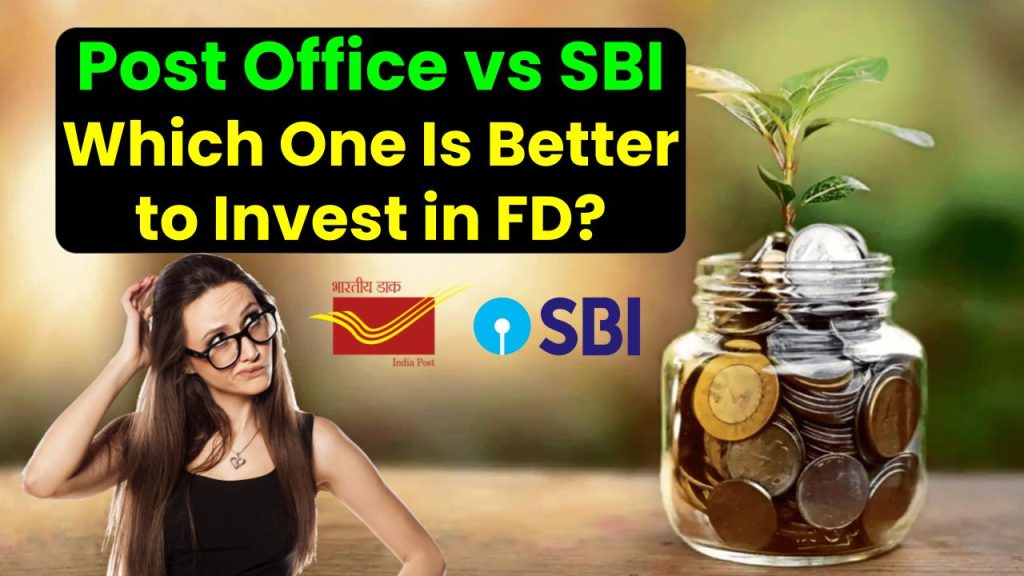
When it comes to safe and stable investment options in India, Fixed Deposits (FDs) remain one of the most preferred choices. Among the most trusted institutions offering FDs are the India Post (Post Office) and the State Bank of India (SBI). But if you’re planning to invest for a period of 5 years, the question arises: Post Office vs SBI – which one is better for a 5-year FD investment?
In this detailed guide, we will compare the interest rates, benefits, tax implications, safety, and convenience of both options to help you make an informed decision. Whether you’re a young saver, a working professional, or a retired senior citizen, this article will simplify your investment journey.
Post Office vs SBI: Which One Is Better to Invest in FD?
| Feature | Post Office 5-Year Time Deposit | SBI 5-Year Fixed Deposit |
|---|---|---|
| Interest Rate | 6.7% per annum (Q1 FY 2025) | 6.5% per annum (General) |
| Senior Citizen Rate | Not Applicable | 7.0% per annum |
| Tax Benefits | Section 80C (up to Rs 1.5 lakh) | Section 80C (up to Rs 1.5 lakh) |
| Minimum Deposit | Rs 1,000 | Rs 1,000 |
| Premature Withdrawal | After 6 months (penalty applicable) | After 5 years (for tax-saving FDs) |
| Safety | Sovereign Guarantee | DICGC-insured up to Rs 5 lakh |
When comparing Post Office vs SBI for a 5-year FD, both options offer safe, low-risk investment avenues with steady returns. For general investors, the Post Office 5-year FD at 6.7% is slightly more rewarding. But senior citizens may benefit more from SBI’s 7.0% rate. Choose based on your age, tech-savviness, and comfort with physical or online banking.
What is a 5-Year Fixed Deposit?
A 5-year fixed deposit is a type of savings account where you deposit a lump sum of money for five years at a fixed interest rate. At the end of the term, you receive your principal along with the accumulated interest. It’s ideal for those seeking guaranteed returns with low risk.
see also: Your money will double in this post office scheme!
Interest Rates Comparison
Post Office Time Deposit (POTD)
As of April 2025, the Post Office offers an interest rate of 6.7% per annum for 5-year FDs. This rate is reviewed quarterly by the Ministry of Finance and is consistent with sovereign backing.
- Compounded quarterly and paid annually.
- Interest is taxable.
SBI Fixed Deposit
SBI offers a 6.5% interest rate on 5-year FDs for the general public. However, senior citizens benefit from an extra 0.50%, making it 7.0% for those aged 60 and above.
- Compounded quarterly.
- Offers monthly/quarterly payout options or reinvestment.
Verdict: For general investors, the Post Office has a slight edge. For senior citizens, SBI offers better returns.
Tax Benefits
Both the Post Office 5-Year TD and SBI 5-Year Tax Saver FD are eligible for tax deductions under Section 80C of the Income Tax Act, up to Rs 1.5 lakh per annum.
- But, interest earned is taxable as per your income slab.
- No TDS is deducted on Post Office FDs, but you must declare the interest.
- SBI deducts TDS if interest exceeds Rs 40,000 (Rs 50,000 for seniors).
Tip: Submit Form 15G/15H (if eligible) to avoid TDS on SBI FDs.
Safety and Risk Factors
Post Office FD Safety
- Backed by the Government of India.
- Offers sovereign guarantee – highest level of safety.
SBI FD Safety
- SBI is a public sector bank, regulated by RBI.
- Deposits insured under DICGC up to Rs 5 lakh.
Both options are extremely safe, but Post Office FDs have zero default risk due to direct government backing.
Convenience and Accessibility
Post Office FD
- Requires physical visit to the Post Office.
- Limited online management options.
- Suitable for rural investors or those preferring face-to-face services.
SBI FD
- Fully digital – can open, renew, or break FDs via SBI YONO app or net banking.
- 24×7 account access.
Verdict: SBI is more convenient for tech-savvy users.
Who Should Choose What?
| Profile | Best Option |
|---|---|
| Senior Citizens | SBI FD (Higher Rate) |
| First-time Investors | Post Office (Safety & Simplicity) |
| Rural/Semi-urban Residents | Post Office (Better Reach) |
| Digitally Active Users | SBI FD (Online Flexibility) |
Step-by-Step: How to Invest in a 5-Year FD
How to Open a Post Office FD:
- Visit your nearest Post Office branch.
- Fill the Account Opening Form (AOF).
- Submit ID proof, address proof, and passport-size photo.
- Deposit at least Rs 1,000 in cash or cheque.
- Choose the 5-year option.
- Collect your passbook/certificate.
How to Open an SBI FD:
Online Method (SBI YONO or Net Banking):
- Log into your SBI account.
- Navigate to Fixed Deposit > Open New FD.
- Enter amount, tenure (5 years), and payout preference.
- Submit and confirm.
Offline Method:
- Visit your nearest SBI branch.
- Carry PAN, Aadhaar, and passport-size photo.
- Fill the FD form.
- Deposit your money.
- Collect FD receipt or passbook.
Real-Life Example
Let’s assume you invest Rs 1,00,000 for 5 years:
- Post Office (6.7%): You will get approx Rs 1,38,196 at maturity.
- SBI General (6.5%): You will get approx Rs 1,37,234.
- SBI Senior Citizen (7.0%): You will get approx Rs 1,40,255.
Figures are approximate and assume annual compounding. Actual returns may vary slightly.
see also: SBI PPF Scheme: You will get Rs 12,00,000 on depositing ₹ 80,000
Post Office vs SBI FD FAQs
Q. Is the Post Office FD better than SBI for 5 years?
If you’re looking for higher safety and slightly better returns (for general investors), the Post Office FD is a strong option. SBI is better for senior citizens due to the higher interest rate.
Q. Can I break my 5-year FD early?
- Post Office: Yes, after 6 months (interest penalty applies).
- SBI 5-Year Tax Saver FD: No premature withdrawal allowed.
Q. Which option is safer?
Both are extremely safe, but Post Office FDs carry a sovereign guarantee, which is the highest level of security in India.
Q. Which has better digital access?
SBI offers superior digital tools and convenience through mobile and internet banking.
Q. Are the interest rates fixed?
Yes, both Post Office and SBI offer fixed interest rates for the full tenure at the time of booking.











